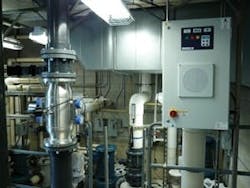About the author: Ron George is vice president, business development – aquatics, for Neptune-Benson. George can be reached at [email protected] or 920.885.4628.
Water quality—we use this term almost daily in the aquatics industry. It refers to the chemical, physical and biological characteristics of the water, and is the measure of the condition of the water relative to the requirements of one or more set of standards against which compliance can be determined.
I often have heard aquatic venues referred to as “communal bathtubs”—not an ideal marketing term. However, in reality, whether you are submersed in a pool or standing under a spraying or dumping water feature, you are “bathing” yourself in front of hundreds of other patrons who also are enjoying the recreational aspects of water.
To many people, water is not dangerous nor unhealthy. They think, “It can’t be. Look at it—it is clean, clear and cool on a hot day.” The issue of maintaining compliant water quality is about what the public does not see. Determining how to better inform the public of its responsibilities when it comes to water quality has been a constant battle in the recreational water industry.
Improved Technologies
Technological advances in pump room equipment provide better-filtered, chemically balanced water. Advances also have occurred on the testing and monitoring side; pools can be accurately treated and monitored remotely using the Internet. Concerns about disinfection byproducts and recreational water illnesses also can be more easily confirmed.
The ability to identify and address water-related issues has improved. Ultraviolet lights, microfiltration, chemical controllers and variable-frequency drives all can be integrated into the treatment process to produce better quality water.
Keeping Codes Current
New technologies are part of a more sophisticated design, and thus require a more sophisticated level of technical support to maintain consistent performance. The primary focus of operators is to comply with health codes. This can sometimes be a challenge when existing codes do not take new technologies into account, or simply do not exist. Many states have not updated codes for years, lagging behind changes in scientific knowledge and technology.
The Centers for Disease Control and Prevention published its Model Aquatic Health Code (MAHC) in 2014. It is based on the most up-to-date research and best practices for public pools. Many states are expected to revise their aquatic health codes using the MAHC. The code itself is broken into several modules so regulators can pick and choose best practices based on proven technology and science to upgrade their existing codes. The overall goal is to eventually have one uniform code throughout the country that will be updated every few years as technology and science warrant. However health codes are revised, the challenge for operators will increase along with the level of technical aptitude required.
Training & Support
A vital part of the equation is the operation of facilities. Training and support on how to use new technologies effectively are required for these technologies to be successful. This is a challenge in the recreational water industry, because many facilities are only open for part of the year, and staff members are, as they should be, primarily focused on lifeguarding skills and water safety.
Technical training for the people responsible for equipment rooms can vary dramatically. The plant equipment room training provided through an Aquatic Facility Operator or Certified Pool/Spa Operator class deals primarily with how to do the various tasks required on a daily basis to comply with current local code: testing and recording. It is not spent on the maintainance, operation and troubleshooting of equipment that has to operate effectively to maintain water quality. The more advanced the equipment and process integration, the greater the challenge.
However, all equipment needs to be monitored and maintained. Many times, operating and service costs are not considered during the purchase. No piece of equipment, no matter how technologically advanced, operates without some degree of human intervention. Technology today does allow monitoring from afar, however. We can watch what is happening in the equipment room from a desktop computer, tablet or smartphone. This gives operators the ability to be proactive instead of reactive. Operators are not plant engineers, though. The industry operates with staff that cannot be expected to be knowledgeable enough to support the technology now in plant equipment rooms.
Never has it been more important for manufacturers to support their installations and have local factory-certified technicians available. As technologies advance, technical service training and support will be critical for successful operation of equipment and consistent water quality.
The reality is that water quality issues cannot be resolved only by upgrading codes or improving technologies. They require owners, operators, regulators and manufacturers working together, as well as public awareness.
Download: Here
